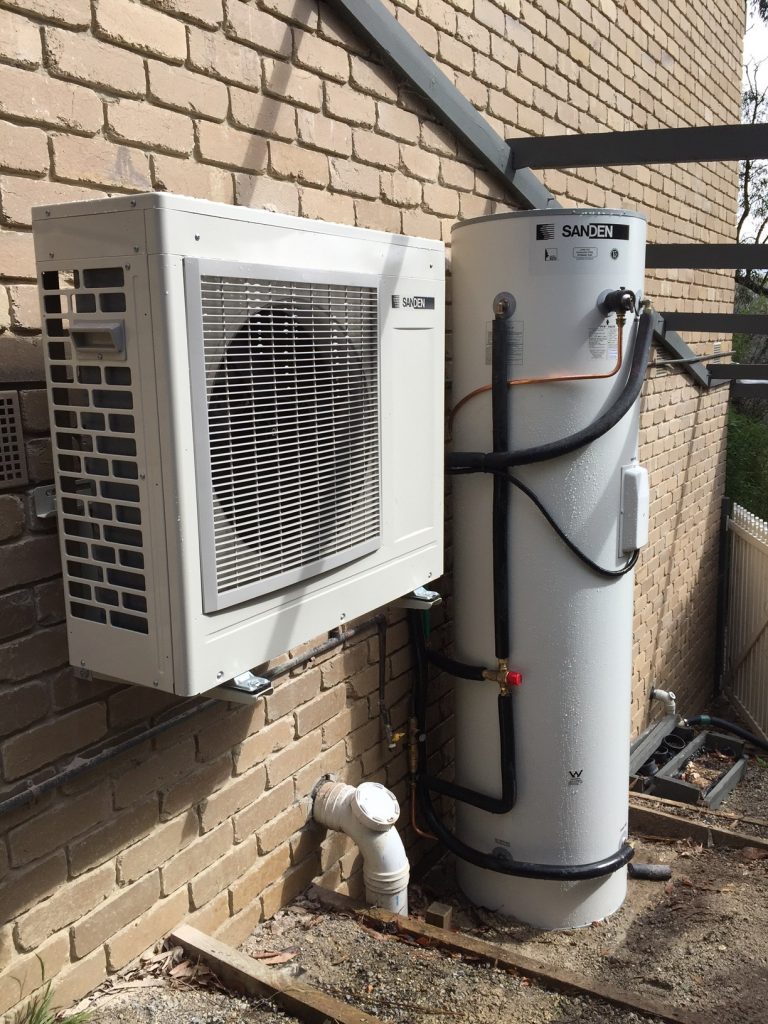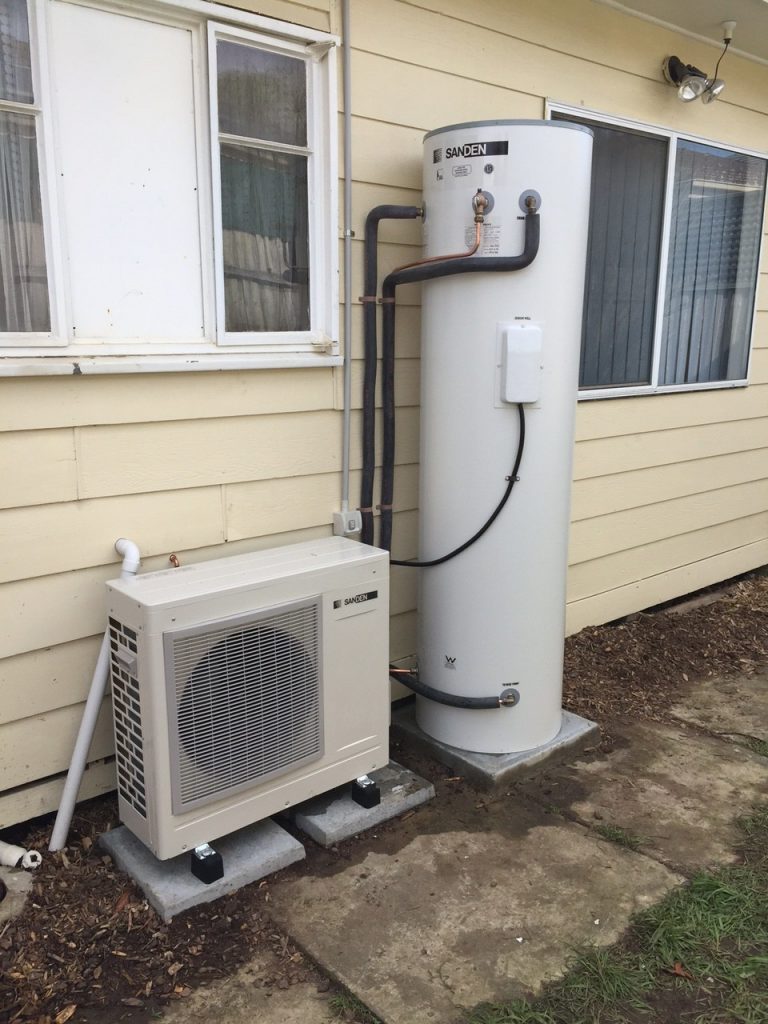Many Australians are doing their bit to reduce their carbon footprint. Small measures, such as insulating our homes better, recycling, and composting food scraps can help. Meanwhile, there is a boom in solar energy, with more than four million Australian homes now having solar panels. While the upfront cost may be a barrier, solar panels and a heat pump can provide nearly all of the energy needed to make a home comfortable.
Is Solar Energy Enough to Power a Heat Pump?
Photovoltaic (PV) solar panels and heat pumps can work together seamlessly to provide home heating and hot water in a truly sustainable way. If you have a large enough solar array, you should be able to run your hot water heat pump with no added grid electricity – maximising your solar savings potentially generating more energy than you use during the daylight hours.
There are two main solar power types: thermal and photovoltaic (PV). Solar thermal effectively heats water, so the heat pump does not have to use as much electricity. PV panels, on the other hand, convert sunlight into electricity, which allows a drop in reliance on fossil fuel-based grid power.
Solar production from Solar arrays is measured in kilowatts (kW), with a typical home system providing 3–4 kW of capacity during max sunlight. A system of that size, 4 kilowatts (kW), needing roughly 26 square meters of roof space, produces approximately 3,400 kilowatt hours (kWh) of electricity per year (production varies depending on weather and time of day).
But, Is That Sufficient?
Most systems around the country hover around the 3,700 kWh yearly mark, so that can be sustainably met with a 4 kW solar panel. However, you may still draw some power from the grid. Most homes are heated by gas-fueled boilers that provide hot water, leading to lower electricity use. By contrast, heat pumps consume more electricity; even the most efficient ones use 3,000 kWh a year.
Solar panels can power your heating and hot water, but you likely won’t cover all your household appliances. Solar typically supplies about half of a home’s electricity needs; the rest comes from the grid or other renewables, such as wind power, based on average output.
How many solar panels do I need to power a heat pump?
The more solar PV panels you can install, the better. Even basic electronics can be too much for a small system to power. You will need at least 26 square meters of solar panels to run a heat pump, but a larger system is better. solar panels come in different sizes from one manufacturer to another; however, a common size panel has a dimension of 1.6 m x 1 m with a thickness of 40 mm. With their extensive surface area, they increase the absorption of sunlight.
Each kilowatt (kW) of solar power requires about four panels, meaning:
- 1 kW system = 4 panels
- 4 kW system = 16 panels (26 m²)
- 6 kW system = 24 panels (39 m²), ideal for larger households
A 4 kW system suits a 3-4 person home, while bigger households may need 5-6 kW for sufficient power. Also note that your solar panel needs may vary based on roof slope and local climate.
Before installing solar panels for a heat pump, consult a qualified engineer. It’s also worth having your plumbing inspected as part of the upgrade process, particularly if you’re switching from a traditional water heater to a heat pump. Outdated or damaged pipes can reduce efficiency and even lead to water leaks over time. Leak detection and basic plumbing maintenance ensure your system runs smoothly and avoids unnecessary water loss or structural issues.
For a smooth installation, professional advice is a worthwhile investment.

Energy Efficiency Strategies Through Solar and Heat Pumps
Solar panels are becoming more popular in Australia, allowing homeowners to generate their own electricity. When paired with heat pumps, they offer efficient climate control by harnessing renewable energy from the sun, air, or earth.
What Is an Air-Source Heat Pump?
An air-source heat pump transfers heat from the outdoor air into your home, efficiently warming air or water. It’s more energy-efficient than traditional systems, easy to install, and works in various climates—helping homeowners reduce energy use and carbon emissions.
What Is a Geothermal Heat Pump?
A geothermal heat pump uses underground pipes (ground-loop system) to transfer heat. It warms homes in winter and cools them in summer by leveraging the stable underground temperature. Though highly efficient and eco-friendly, installation costs are higher than other heat pump types.
How Efficient Are Solar Panels?
Solar panels typically convert 15-20% of sunlight into electricity. Efficiency depends on panel type, weather, location, and angle. Over time, performance may decline, so regular maintenance and cleaning help maintain efficiency.
Heat Recovery Ventilation Can Be Used in Conjunction With a Combined System
Buildings with good air circulation often use exhaust air retrieval systems. This recovered heat can be used for space heating and hot water when combined with heat pumps and solar panels. Some setups even allow solar energy storage for later use, maximizing efficiency and cost savings. Professional installation ensures optimal performance.
Carbon Emissions From a Structure Are Reduced
Combining solar panels with heat pumps helps lower carbon footprints considerably—particularly in commercial space. One case revealed a 64% CO2 saving, from 5.4 metric tons per year to 2.0. Adopting sustainable solutions allows businesses to gain energy efficiency ratings and a much-improved public image.
Maximizing Solar Energy With Heat Pumps
Most homeowners consume only 50% of their solar power and send the rest to the grid. Heat pumps raise self-consumption by 20% by delivering consistent low-energy heating over time and utilizing solar energy more effectively.
Falling Prices & Incentives
The price of solar panels and heat pumps is falling, making them widespread. Sustainable energy solutions are becoming accessible to homeowners and businesses due to lower costs, government incentives, and rebates.
Important Notes
Combining solar panels with heat pumps allows cheaper heating and cooling, reduces carbon emissions, and provides significant energy savings without sacrificing comfort. This dual renewable energy system makes it easier and more affordable to have an energy-efficient home.
Can Solar Energy Power a Heat Pump?
Yes! Photovoltaic panels convert the sunlight into clean electricity to power the system, ultimately providing a heating and cooling solution that is both affordable and sustainable. However, efficiency is reliant on panel size, orientation, climate and location. Make sure your home is optimal for this setup with a professional assessment.

